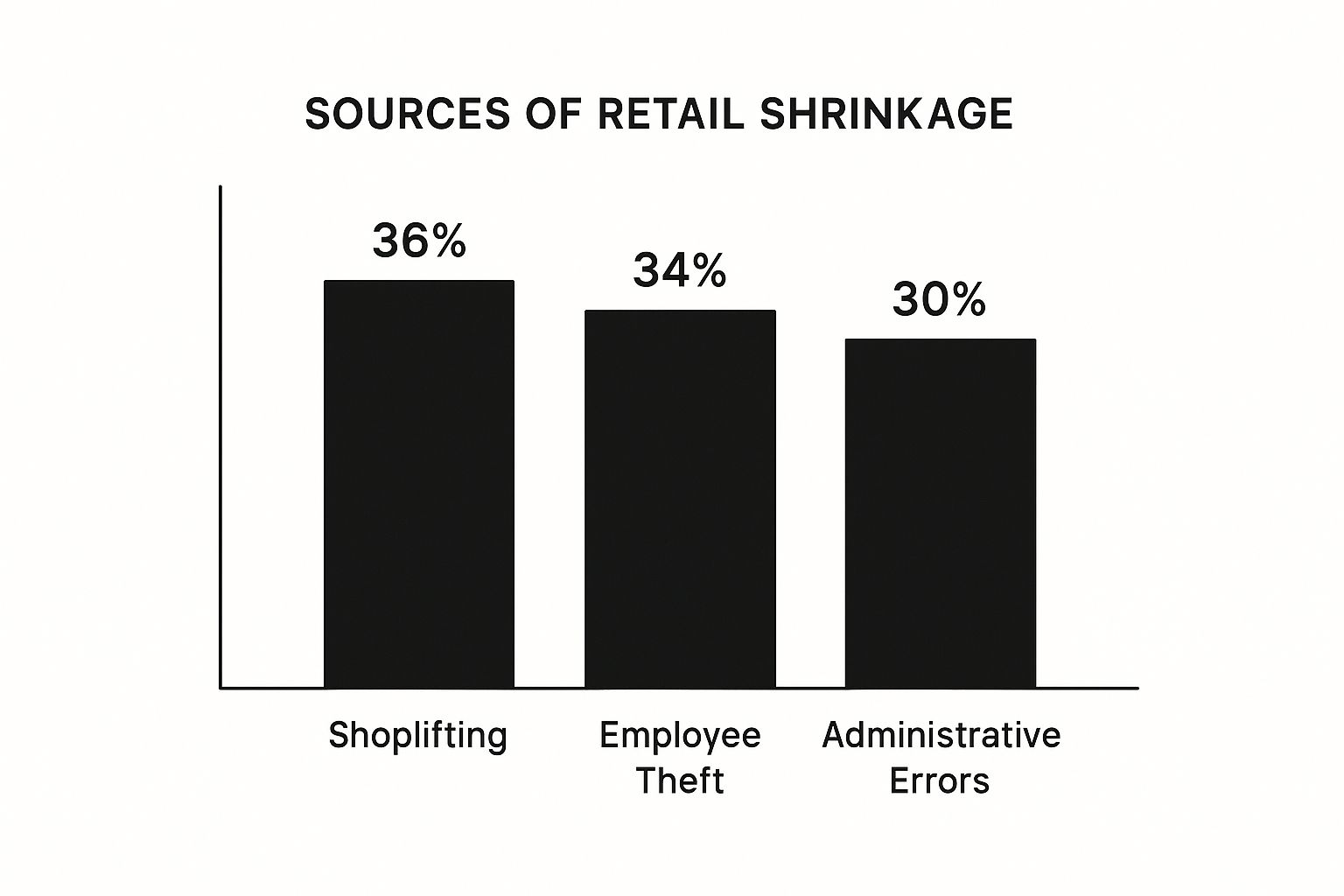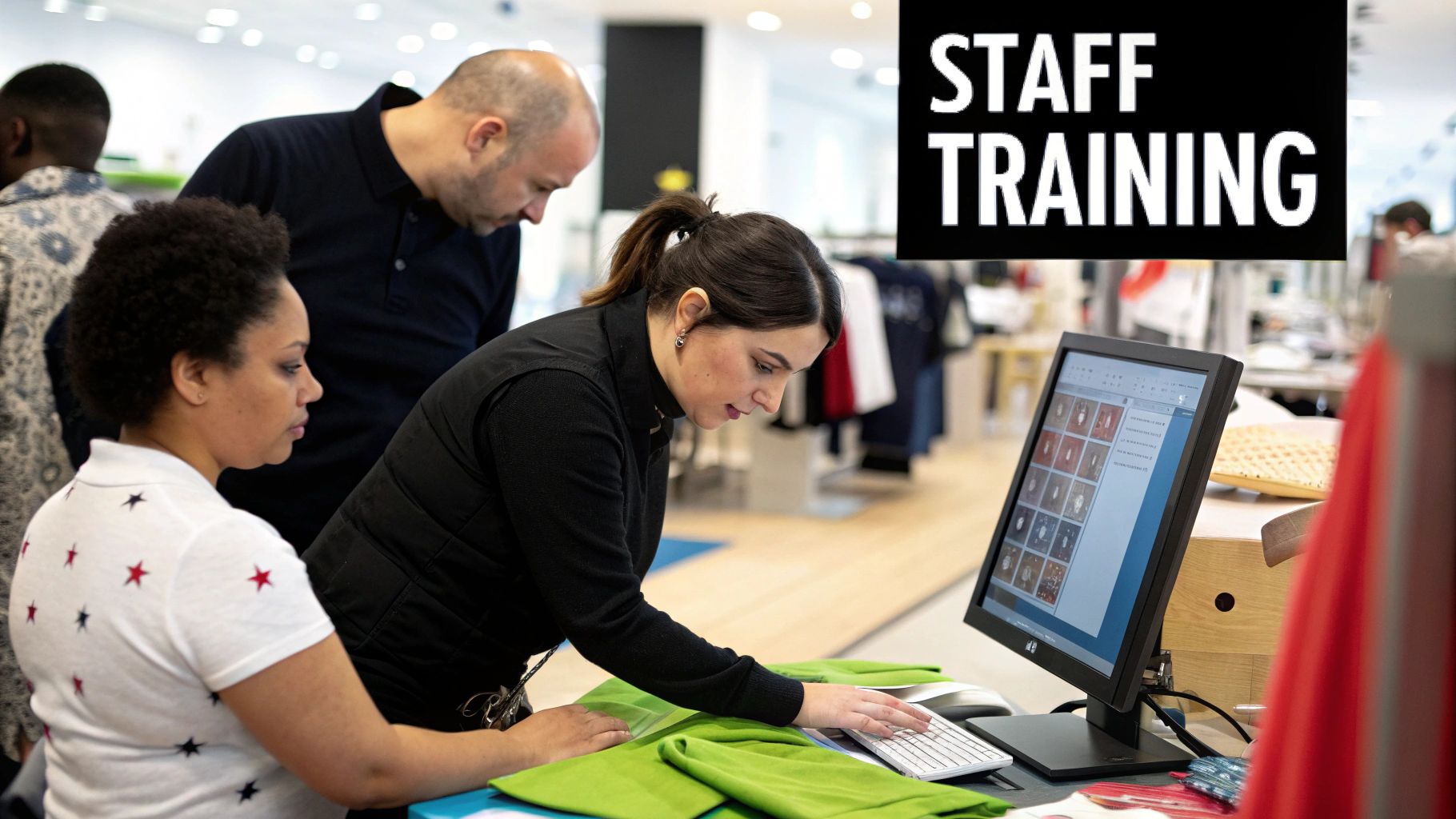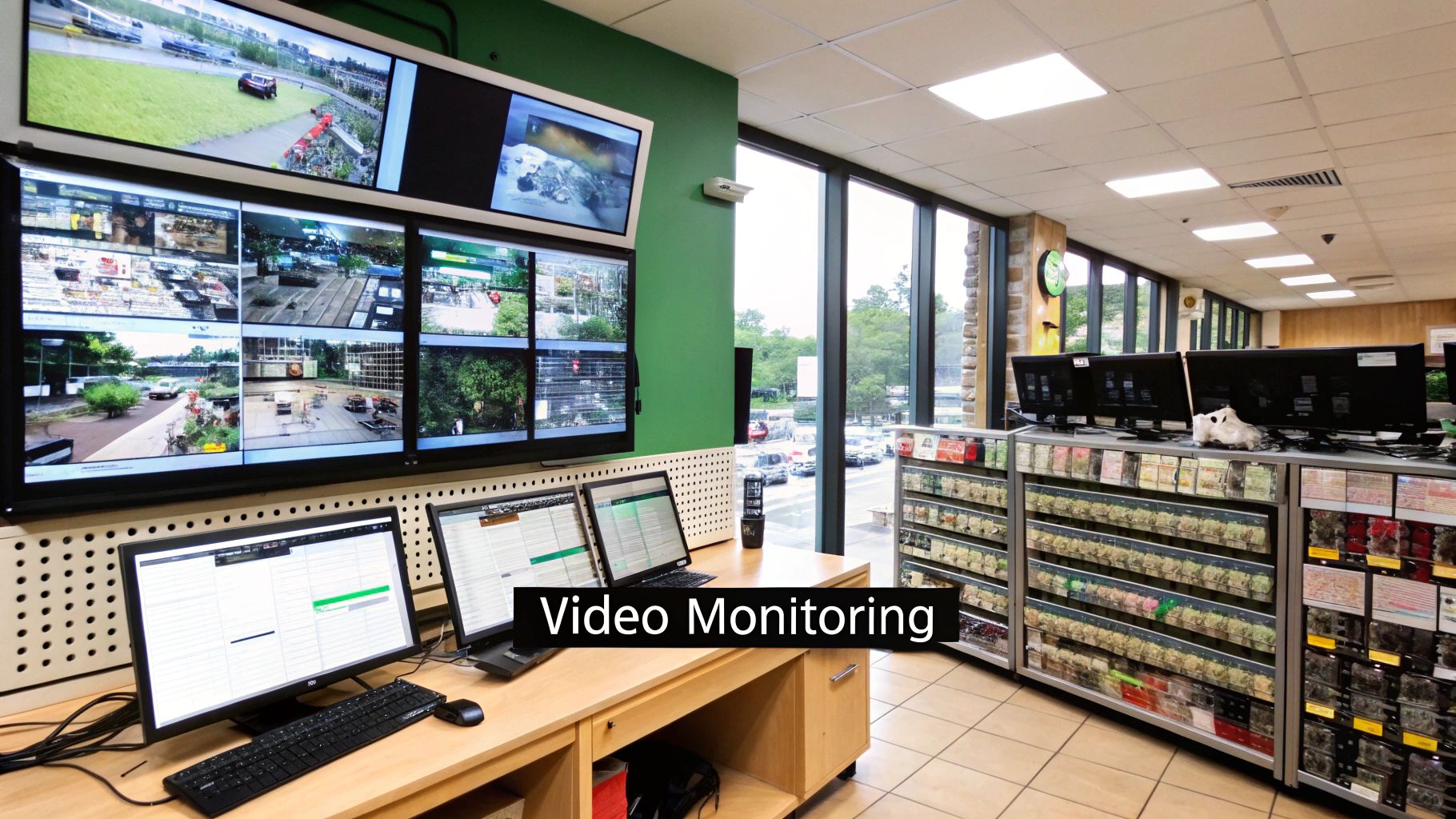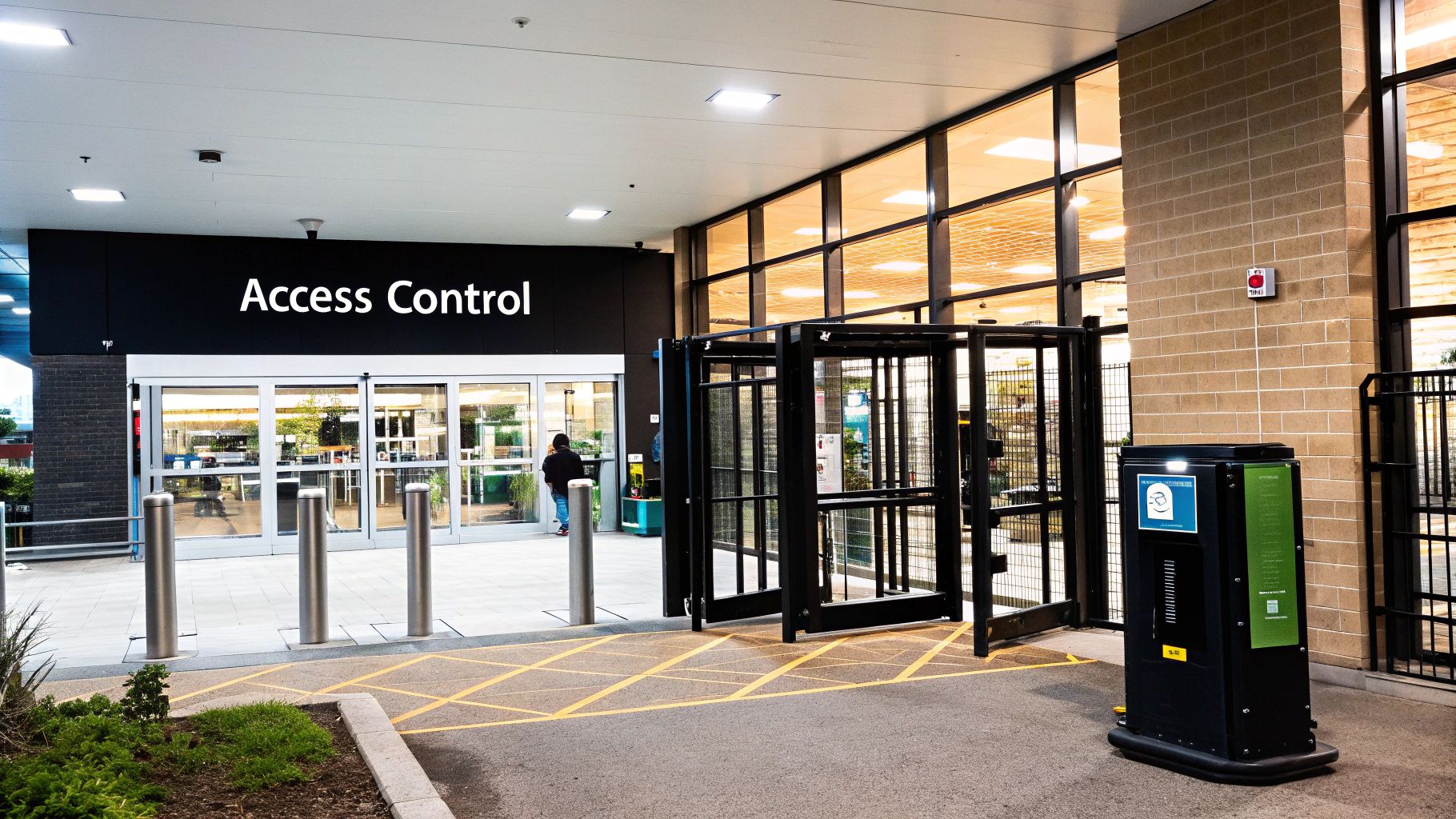Loss Prevention Retail: Protect Profits & Prevent Theft
- Бонус за регистрацию онлайн казино
- 6 days ago
- 14 min read
The Hidden Profit Drain Every Retailer Faces
Think you know where your profits are disappearing to? Many retailers are shocked when they uncover the real scope of their losses. It’s not just the shoplifters you catch red-handed. There’s a whole web of factors quietly draining profits, a tangled mix of employee mistakes, vendor fraud, administrative slip-ups, and increasingly clever criminal tactics.

The infographic above paints a clear picture of this challenge. Three key areas – shoplifting (36%), employee theft (34%), and administrative errors (30%) – make up the lion’s share of retail shrinkage. Tackling each of these requires a unique approach.
Understanding The Impact of Shrinkage
Imagine a small leak in your home’s plumbing. A tiny drip here and there might seem insignificant, but over time, those drips add up to a substantial amount of wasted water. Shrinkage is like that leaky faucet, constantly dripping away your profits. It's the gap between the inventory you should have on hand and what you actually have, and it hits your bottom line directly.
While shoplifting often makes the news, internal issues and administrative errors can be just as damaging. Think about a clothing store: a misplaced box of premium jeans could easily mean hundreds of dollars lost. A simple pricing error at the checkout, repeated multiple times a day, can also add up surprisingly fast.
The financial blow from shoplifting alone is massive, with retailers losing upwards of $13 billion annually – that translates to more than $35 million lost each day. This highlights just how crucial effective loss prevention strategies are. And when you factor in the broader picture of shrinkage—including all forms of theft, fraud, and administrative errors—the cost to the global retail industry balloons into the tens of billions each year. For a deeper dive into shoplifting statistics, check out this resource: Shoplifting Statistics.
To understand the total impact of shrinkage, let's break down the typical annual losses by category:
To help visualize the different types of retail losses and their impact, take a look at the table below:
Annual Retail Loss Breakdown by Category:
Loss Type | Percentage of Total Loss | Average Annual Cost | Detection Difficulty |
|---|---|---|---|
Shoplifting | 36% | Varies widely | Medium |
Employee Theft | 34% | $770,000 per incident (average) | High |
Administrative Errors | 30% | Highly variable, can be significant | Medium to High |
Vendor Fraud | Varies | Can be substantial | High |
Organized Retail Crime | Included in Shoplifting (often a large portion) | Significant, contributes to overall shoplifting figures | High |
Note: These figures are estimates and can vary based on several factors including the specific retail sector, company size, and geographic location.
As this breakdown demonstrates, the financial impact of various loss types can be significant and often difficult to detect. Understanding these different categories is the first step toward building a comprehensive loss prevention plan.
The Psychology of Loss
Effective loss prevention means understanding the "why" behind these losses. Shoplifters run the gamut from opportunistic individuals snatching a small item to highly organized groups targeting high-value goods for resale. Employee theft can be rooted in financial struggles, resentment towards the company, or just a simple lack of understanding about the consequences of their actions. Administrative errors often result from insufficient training, outdated systems, or plain human error.
Shifting Your Perspective
The best retailers don't just react to theft – they proactively invest in protecting their profits. They view their stores through a security lens, identifying weak points in store layout, procedures, and staff training. Think of it like a chess game: anticipating your opponent’s next move is essential to winning.
This involves understanding the typical tactics shoplifters employ and developing counter-strategies. For example, strategically placed mirrors, visible staff presence, and unobstructed sightlines can deter potential thieves simply by making them feel like they're more likely to get caught. By grasping the psychology driving different types of loss, you can create a store environment and train your team to minimize vulnerabilities and foster a culture of loss prevention.
How Smart Technology Is Changing the Game

Imagine a security guard with superhuman abilities: never sleeping, spotting patterns invisible to the human eye, and constantly learning from every event. That’s the promise of today's smart retail technology in loss prevention. It’s reshaping how businesses protect their goods and bottom line. We'll explore practical applications of Artificial Intelligence (AI) and machine learning making a real difference.
This isn't just about basic security cameras anymore. We're talking about intelligent systems that predict and prevent problems before they impact your profits. We'll separate genuine advancements from marketing hype, drawing insights from retailers who've actually implemented these solutions.
Seeing the Unseen with Computer Vision
One of the most fascinating advancements is computer vision. Think of it as giving your security system a brain. Computer vision analyzes video feeds live, pinpointing suspicious actions a human might miss.
For example, imagine someone repeatedly picking up and putting down the same item, or loitering in one spot. The system flags these behaviors as potentially suspicious. This allows security to step in proactively or review the footage later for a deeper investigation.
A growing trend in loss prevention is the increased use of technology, particularly AI and machine learning. AI-powered surveillance can detect unusual activity in real-time, enabling faster responses to potential theft.
These systems often outperform human observation in spotting suspicious behavior. Some computer vision solutions even track customer movement and shelf conditions, improving both security and sales. To delve deeper into this, explore the future of loss prevention here.
Predicting Risk with Data
Predictive analytics takes loss prevention retail to a new level. It analyzes data – from sales transactions and inventory levels to weather and local events – to anticipate potential high-risk scenarios.
For instance, the system might notice a link between certain days, times, and increased shoplifting. With this knowledge, retailers can deploy security resources more strategically, scheduling more staff during these high-risk periods.
This marks a key shift from reacting to incidents after they occur, to preventing them before they happen. Predictive analytics empowers retailers to minimize losses proactively.
Balancing Security with Customer Experience
A major challenge with smart loss prevention technology is finding the sweet spot between security and the customer experience. Overly intrusive measures, like constant visible surveillance or frequent staff interventions, can create a hostile atmosphere and drive customers away.
The best loss prevention strategies seamlessly integrate technology, providing robust security without making honest shoppers feel like suspects.
Real-World Successes (and Failures)
While the potential of smart technology is huge, the journey isn't always easy. Some retailers have drastically reduced shrinkage using these tools, while others have faced challenges like false alarms, unhappy customers, and complex system integrations.
We'll examine real-world examples of both wins and losses, sharing valuable lessons from retailers on the front lines. Understanding these potential hurdles is vital for making informed decisions about which technologies are right for your business and how best to implement them.
Ultimately, the goal is to find solutions that maximize security while minimizing disruptions to the customer experience, ensuring a strong return on your loss prevention investment.
Building Your Team Into Your First Line of Defense

Many retailers think loss prevention is all about catching shoplifters red-handed. But that's only a small piece of the puzzle. True loss prevention is like building a fortress—it's about making your store an environment where theft is much less likely to occur in the first place. And your team? They're the front-line defenders.
But like any good defense, they need the right training. Smart retailers know that every employee, from the stockroom to the sales floor, can contribute to security without needing to be a dedicated security guard.
The Subtle Art of Deterrence
Think of it this way: imagine walking into a store where you’re greeted warmly, offered help, and made to feel welcome. This isn't just good customer service; it's a powerful, yet unobtrusive form of natural surveillance. A shoplifter is far less likely to try anything when they feel like they’re being watched.
Leading retailers position their staff strategically throughout the store, creating a visible presence. This, combined with genuine customer interaction, acts as an effective, almost invisible security layer. It’s all about creating a positive shopping experience while simultaneously discouraging potential theft.
Empowering Your Staff Through Training
Effective loss prevention training isn’t about turning your employees into undercover detectives. It's about teaching them to be observant without being intrusive. They learn to spot suspicious behavior—like someone repeatedly entering and leaving the store, or constantly looking over their shoulder—and how to respond appropriately.
Instead of directly confronting someone, a trained employee might simply approach them, offer assistance, and make them feel seen. This simple act can often be enough to deter theft. Training also covers how staff can effectively communicate with each other and security personnel if needed.
Balancing Service With Security
The trick is finding the sweet spot. You want a vigilant team, not an overzealous one. Overly aggressive security can drive away honest customers and damage your brand. That's why thoughtful training is so important. It’s about empowering staff, not intimidating shoppers.
To illustrate the components of effective training, take a look at the table below:
Table: Staff Training Components for Effective Loss Prevention Description: Essential training elements that transform regular retail staff into effective loss prevention partners
Training Component | Time Investment | Effectiveness Rating | Customer Impact |
|---|---|---|---|
Customer Service as Deterrence | 4 hours | High | Positive |
Recognizing Suspicious Behavior | 2 hours | Medium | Neutral |
Communication Protocols | 1 hour | High | Neutral |
Emergency Procedures | 1 hour | High | Positive |
As the table highlights, effective training blends customer service with security awareness, creating a positive impact overall.
The Power of a Proactive Team
In the world of retail loss prevention, your best investment isn't the latest high-tech gadgets; it's your people. A well-trained, engaged team is more valuable than the most sophisticated security system.
Employees who feel invested in the store's success will naturally be more proactive in preventing loss. They become your eyes and ears on the ground, fostering a culture of security throughout the entire shopping environment. This proactive mindset significantly strengthens your entire loss prevention strategy.
Why Loss Prevention Retail Is Your Best Investment Opportunity
Let's talk frankly: effective loss prevention in retail isn't about spending money, it's about making it. While many businesses focus on driving sales, savvy retailers understand that investing in loss prevention can be more profitable than pouring money into marketing. It’s about protecting your profits, not just chasing new ones.
The Growth of the Loss Prevention Market
The retail loss prevention market is exploding. This isn't random; it's driven by advancements in technology and a growing realization that strong loss prevention is essential. In 2023, the market was valued at $44.17 million and is expected to grow at a 13.68% compound annual growth rate (CAGR) from 2024 onward. North America and Europe are currently leading the charge, thanks to their well-established retail industries and early adoption of new technologies. For a deeper dive into market trends, check out this article: The State of Loss Prevention in 2025. This growth presents huge opportunities for retailers who are willing to take a strategic approach to security.
From Expense to Profit Center
Many see loss prevention as a necessary evil, a drain on resources. But innovative retailers are changing that perception, turning it into a source of profit. How? By understanding that reducing loss directly boosts the bottom line.
Think of it this way: every item shoplifted or damaged represents not only the cost of the goods but also the lost profit margin. Investing in effective loss prevention isn't just about replacing stolen items; it's about reclaiming that lost profit. This change in perspective allows retailers to see loss prevention as a strategic investment, not just an overhead cost.
Leveraging Market Evolution
The constantly changing loss prevention market offers a unique advantage. As technology improves, costs often come down, making advanced solutions more affordable. Retailers who embrace these technologies early gain a competitive edge, enjoying better security and higher profits. They can implement the latest tools and techniques before their rivals, protecting their earnings and solidifying their position in the market.
The Early Adopter Advantage
Being an early adopter in retail loss prevention is more than just having the newest gadgets. It’s about gaining valuable experience, refining strategies, and building a strong foundation for long-term security. These retailers become experts at spotting and minimizing risks, creating a more secure and profitable business. They learn what works and what doesn't, adapting their strategies to meet emerging threats. This constant improvement leads to a more resilient operation, outperforming competitors in both security and profitability. By proactively addressing loss prevention, retailers are setting themselves up for sustained growth and long-term success.
Creating Interconnected Defense Systems That Actually Work
Think of retail loss prevention like building a secure home. You wouldn't just rely on a single lock on the front door, right? You'd likely have multiple layers of security – deadbolts, window alarms, maybe even a security system. Effective loss prevention in retail works the same way. Retailers who consistently minimize loss understand that one solution isn't enough. It's about building a system where technology, staff, and processes all work together.
Imagine a burglar casing a house; multiple layers of security make them think twice. It's the same for shoplifters.
This screenshot from the Wikipedia article on loss prevention illustrates this point: The image emphasizes how even simple visual deterrents like signs and the awareness of active monitoring contribute to a more secure environment.
Layering Your Defenses
Picture a customer walking into your store. From the moment they enter to the moment they leave (and even after), there are opportunities to create layers of protection. Successful retailers blend physical security measures, such as strategically placed cameras and mirrors, with technological solutions like AI-powered video analytics. Critically, they also invest in comprehensive staff training. These combined elements create a security net that's practically invisible to honest shoppers but a major deterrent to those with less-than-honorable intentions.
Deterrence: Visible and Invisible
Effective deterrence is like a good cop/bad cop routine. You have the visible deterrents – security cameras, security tags, and clear signage – that act as the “bad cop,” sending a direct message that theft won't be tolerated. Then, you have the more subtle “good cop” tactics: staff engaging with customers, optimized store layouts, and placing high-value items within staff sightlines. These create a sense of being observed without making the environment feel hostile.
Think of a friendly store greeter. They welcome customers, but their presence also subtly discourages shoplifting.
Integrating People, Processes, and Technology
Let's say you own a clothing store. A customer is trying on clothes in a fitting room. You have cameras, of course, but a trained staff member might casually check in, offering different sizes or styling advice. This customer service interaction is also a subtle form of deterrence. Now, add smart fitting room technology that tracks items taken in and out, alerting staff to discrepancies. This blend of human interaction, established procedures, and technology demonstrates a layered loss prevention approach.
From Entry to Exit and Beyond
Security doesn't stop at the checkout. Consider your loading dock, stockroom, and even your online sales platform. Each area has its own vulnerabilities. Successful retailers extend their layered approach throughout their entire operation. Strict receiving procedures combined with robust inventory management software like Zoho Inventory can prevent internal theft and errors. Even simple things like good lighting and clear signage in storage areas can make a big difference.
By creating these interconnected defense systems, retailers build a comprehensive security net. This net addresses a variety of risks, protects profits, and creates a safer space for both customers and employees. It’s about building a culture of security that's woven into every part of your business. This proactive approach isn't just a good idea – it’s crucial for success in today’s retail landscape.
Measuring What Matters and Improving Continuously

Many retailers rely on shrinkage percentages to measure the success of their loss prevention efforts. It’s like checking the final score of a game – you know who won or lost, but not how the game played out. Shrinkage tells you the what, but not the why. This makes it difficult to learn and improve. The best retailers, however, pay close attention to leading indicators. Think of these as the in-game statistics that reveal the real story.
Leading indicators offer clues about potential problems before they become big losses. They're like the subtle coughs and sniffles that warn you might be getting sick, letting you rest and recover before a full-blown cold takes hold.
Key Performance Indicators (KPIs) That Actually Matter
If shrinkage is the final score, what are the key in-game stats for retail loss prevention? It's about understanding the nuances of your operations. For instance, consider your detection rates. How often do your staff or systems catch shoplifting attempts? This tells you a lot about the effectiveness of your training and security setup.
Then there’s response effectiveness. When an incident is detected, how does your team handle it? A swift, smooth response minimizes disruption for everyone and keeps your staff and customers safe. It’s more than just apprehending shoplifters; it’s about managing the entire situation effectively.
Two other critical metrics often get overlooked: customer satisfaction and team engagement. Overbearing security can alienate paying customers, so finding the right balance is key. And engaged employees are naturally more observant and proactive, acting as your first line of defense. Together, these metrics paint a much more complete picture than shrinkage alone.
Actionable Insights, Not Just History Lessons
Your measurements should do more than just record past losses; they should guide future actions. This means digging deeper into the data to find trends and patterns. For example, noticing a spike in thefts on certain days or times allows you to adjust staffing, implement targeted security, or even rethink your store layout.
Top-performing retailers use data to constantly refine their strategies. They analyze what's working, what's not, and adapt accordingly. It’s a continuous cycle of learning and improvement, driven by the insights they glean from their data.
Avoiding Common Measurement Mistakes
One common trap is fixating on the wrong metrics. Obsessing over tiny inventory discrepancies can distract from bigger problems, like organized retail crime. It's like worrying about a small scratch on your car while the engine is on fire.
Another mistake is ignoring the outside world. Economic downturns or local events can significantly influence shrinkage rates. Overlooking these external factors can lead you to faulty conclusions and ineffective solutions.
Finally, beware of “vanity metrics” – numbers that look good on paper but don’t tell the whole story. Simply tallying the number of shoplifters caught doesn’t necessarily translate to a reduction in overall losses. Focus on the metrics that truly impact your bottom line, like the value of recovered merchandise and the actual decrease in shrinkage.
Creating Accountability: Metrics That Drive Improvement
Loss prevention isn’t just the security team’s job; it’s everyone’s responsibility. Effective measurement systems create accountability across the entire organization. By linking individual and team performance to key metrics, you ensure everyone understands their role in protecting profits.
This shared responsibility builds a culture of proactive loss prevention. When everyone is accountable, they become more vigilant and more likely to spot and report potential risks. This collaborative approach can dramatically strengthen your overall strategy, creating a safer and more profitable retail environment.
Your Strategic Implementation Roadmap
Ready to rethink your approach to retail loss prevention? It's not about splashing out on the most expensive tech or hiring an army of security guards. It's about making smart, targeted decisions that deliver results within your budget and operational realities. This section offers a practical, step-by-step guide for retailers of all sizes, from small boutiques just starting out with loss prevention to larger chains looking to revamp their existing systems.
Prioritize for Maximum Impact
Think of your loss prevention budget like a garden. You want to plant the seeds that will yield the biggest harvest. Start by pinpointing your biggest vulnerabilities. Is shoplifting your primary concern, or is employee theft draining your profits? Focus your resources where they'll make the biggest difference.
For example, if shoplifting is a problem near the entrance, investing in visible security cameras and having a friendly greeter might be your best initial move. If you suspect internal theft, improved inventory management software and focused staff training could provide a much better return. Don't try to tackle everything at once; concentrate on the areas where you can see immediate results.
Avoid Costly Pitfalls
Implementing new loss prevention measures can be a minefield. One common mistake is rushing the process. Imagine installing a new point-of-sale system without proper training. It's a recipe for frustration, errors, and wasted resources.
Another trap is overspending on complicated solutions when simpler ones would do the trick. A small boutique doesn't need the same level of security as a major department store. Assess your needs realistically to avoid unnecessary costs.
Realistic Timelines for Smooth Transitions
Building a successful loss prevention program takes time. Create a realistic timeline that allows for testing, training, and adjustments as you go. Trying to implement too much too fast can disrupt your daily operations and lead to staff burnout.
Think of it like learning a new language. You wouldn't expect to be fluent overnight. Break the process into manageable stages and be prepared for occasional setbacks. This approach minimizes disruption and sets you up for long-term success.
Building Momentum and Long-Term Success
Start with achievable “quick wins” to build momentum and demonstrate the value of your efforts. Something as simple as training staff to recognize suspicious behavior can lead to immediate improvements. These early successes create enthusiasm and make it easier to get buy-in for larger, more complex projects later on.
Just like building a house, a strong foundation is essential. Quick wins create initial impact, but long-term success requires establishing robust underlying processes and systems. This includes developing clear policies, investing in reliable technology, and fostering a culture of security within your team.
Adapting to Growth and Evolving Threats
Your retail loss prevention strategy needs to be dynamic. As your business grows and new threats appear, your approach must evolve too. Regularly review your performance, analyze market trends, and adjust your strategies accordingly.
For example, the rise of organized retail crime might require implementing more advanced security measures than you initially planned. Staying adaptable allows you to stay ahead of the curve and protect your bottom line effectively.
Ready to build a robust and tailored loss prevention system for your business? Learn more about PCI's comprehensive audio-video security solutions at PCI Audio-Video Security Solutions. We offer advanced security cameras, access control, and alarm systems tailored to your specific needs.

Comments